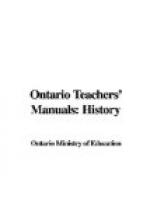The teacher next explains how people sent letters, etc., before post-offices were instituted, and shows that the postmaster, in doing his work, is doing it as our representative, and that we should help him in the performance of his duty by plainly addressing our letters, etc.
A further explanation as to the manner of appointment and payment of salary may follow.
In another lesson, the secondary duties of the postmaster—the registration of letters, issuing of money orders and of postal notes, the receiving and forwarding of money to the Savings Bank, and the making of reports to the Post-office Department—may be discussed.
In teaching these the objective method should be used. The teacher should obtain envelopes of registered letters and a registration blank, a blank money order, and a blank postal note, and instruct the pupils in the proper method of filling out these forms.
FORM III
THE CAPTURE OF QUEBEC
The introduction to this lesson will consist of questions recalling the matter of the past lesson or lessons, and the positions of the British and the French forces in the spring of 1759. This can be easily done by sketching on the black-board a map of North America and marking on it with coloured chalk the position of each force. The chief settlements to be mentioned in the lesson of the day should also be marked. For the matter of this see The Ontario Public School History of Canada, pages 83-97, and Parkman’s Montcalm and Wolfe.
The teacher describes the voyage of Wolfe from Louisburg to Quebec, mentioning the means taken to secure pilots and to overcome the difficulties of navigating the St. Lawrence.
When the pupils, following the voyage, have arrived at Quebec, a description of the topography of the vicinity should be given, and an enlarged sketch, or better still, a plasticine model, made to show this. (See text-book, page 100.) The difficulty of capturing Quebec may be emphasized by reference to former attempts. On this sketch or model the disposition of the French forces should be shown, and then problems may be given as to actions that might be taken by Wolfe. For example: How would you attempt to destroy the fort? Where may Wolfe land his soldiers? What led the French to place their soldiers down as far as the Montmorenci? No doubt some wrong answers will be given, but the probability is that some boy will say that he would take some guns to the high bank on the Levis side and bombard the town of Quebec. The teacher will then tell what was done and with what results.
This should be outlined briefly on the black-board, and problem questions proposed as to the attempt of Wolfe to dislodge the French at Montmorenci.
This second step is also told and added to the outline, after which the teacher proceeds to explain the final step, dwelling particularly on the illness of Wolfe, his careful arrangement of plans, the courage shown in attempting the surprise of the hill, the speed with which his forces were drawn up on the Plains, the battle with its final outcome.




